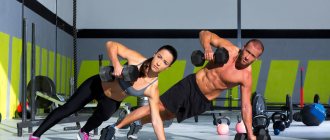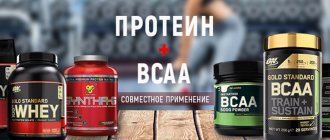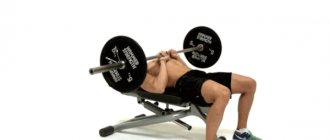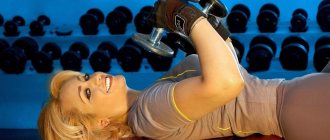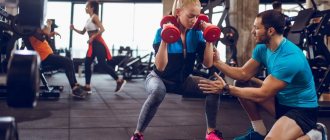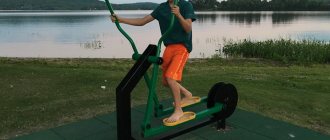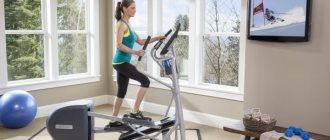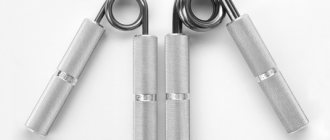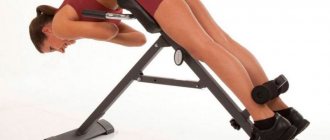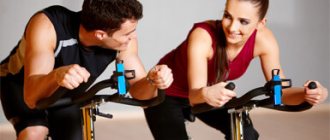Very few articles are devoted to the pace of exercises in bodybuilding. Even in ordinary articles on training methods, you will very rarely find a mention of exactly how fast you should perform the approach. So it turns out that a novice athlete does not think about this most important component of training at all. As training progresses, almost everyone develops the habit of following a certain average pace of performing the exercise: quickly lifting the weight, slowly lowering it. But why is this necessary and what does varying the tempo provide? Almost no one thinks about this.
Speed of exercises (tempo)[edit | edit code]
It has been established that different tempos of approaches or the speed of performing an exercise significantly affect the result of the training.
There are three types of power movement
:
- Positive (involves slowly lifting loads).
- Negative (involves a slower descent than ascent).
- Static (provides for weight retention).
There are several types of tempos for performing exercises.
:
- Fast (lifting load in less than 2 seconds).
- Medium (lifting the load 2-4 seconds).
- Slow (lifting the load for more than 4 seconds).
The speed of performing exercises to increase mass[edit | edit code]
Effect of repetition speed on muscle cross-sectional area Pre - before training, Post - after 8 weeks of training
To increase muscle mass, perform exercises at a medium or fast pace. It is this stage of training that promotes maximum muscle mass gain and recruits more muscle fibers.
The speed of performing exercises to increase strength[edit | edit code]
Classic training for maximum strength involves slow full-amplitude movements (up to 4 seconds - concentric phase and up to 4 seconds eccentric). The slow eccentric phase is especially often practiced.
However, it is worth doing plyometric training periodically.[1] In this case, the exercises are performed with a short concentric phase (about 1-2 seconds at the maximum possible speed of movement), followed by an eccentric phase (about 2-3 seconds). It is recommended to pause (about 1 second) before the next contraction. These workouts are performed with lighter weights and are aimed at developing explosive strength.
The speed of performing an exercise to burn calories[edit | edit code]
In this case, it is not the speed of the exercise that plays an important role, but the overall pace of the workout. The greater the volume of training per unit of time, the higher the energy consumption.
Practical use of tempo
Weight loss programs can use tempo to simultaneously target muscle fiber development. To do this, it is necessary to perform the first part of each approach with explosive speed, and the second, on the contrary, very slowly. This is the John Schaeffer technique. The initial stage of the movement allows you to use the resources of the whole body, which is why it is performed at an explosive pace. As a result, all physiological systems of the body begin to work on a specific muscle group. As a result, we achieve fat burning. And subsequent slow repetitions tire the muscle and cause it to hypertrophy.
This method, like any other, is used only for a while, after which it is replaced by other methods of training. Thus, when developing training programs, the most important tool is tempo. It is not difficult to understand the principles of using tempo and practically use them in your training. You will like the result.
Slow negatives
Slow “negatives” are useful when working towards muscle hypertrophy. As for strength indicators, slow “negatives” turn out to be effective for short-term increases and are virtually useless over a long period of time. That is, you should use slow negatives only in the immediate vicinity of the start, if we are talking about competitions in which the most important indicator is maximum strength.
An interesting point made by Ian King regarding the "negatives" is that he insists that the MAIN WORK DURING THE NEGATIVE PHASE OF THE MOVEMENT IS DONE IN THE LOWER THIRD OF THE AMPLITUDE. THAT IS, THERE IS NO SENSE IN STARTING THE MOVEMENT SLOWLY SO THAT AT SOME MOMENT JUST DROP THE WEIGHT. It’s better to quickly go through the upper half of the amplitude so that the main forces are spent on slow movement in the lower one.
Ego problem
Very often, many (especially beginners) refuse to go at a slow pace because they are too worried about what others will think of them.
For example, they can do 5 pull-ups in 30 seconds, slowly rising and slowly lowering, or they can do 20-25 pull-ups in the same time at a maximum pace. There is no doubt that those who look from the outside will be much more impressed by the second option. But we don’t come to the site to impress someone with our workout, right? We come to exercise, to become healthier, stronger and more beautiful! Therefore, when we train, we should think only about our training and our goals and do only what will bring us closer to the desired result!
100-day workout - Contents
When is it better to use short amplitude?
It is necessary to remember about partial repetitions when training slow muscle fibers . Partial repetitions lead to powerful pumping and impede blood flow in the muscle, which in turn leads to hypoxia (blood does not carry oxygen) and anaerobic glycolysis with the formation of lactic acid and hydrogen ions necessary to trigger the growth of MMV.
The pumping ligament + constant tension in the muscle (under the influence of partial amplitude) is more effective than pumping alone. Read more in the article Growth of slow muscle fibers.
- Power breakthrough
Use partial repetitions to break through the strength ceiling of an exercise. Various lockouts in the bench press, for example. We train the Golgi tendon complex to “give up”, allowing you to take on more weight.
- Tendon and ligament training
Truncated amplitude, amplitude equal to zero (static) trains your ligaments and tendons. A short amplitude will be useful as part of any strength training program, but as an addition, and not as the basis of training.
- Ligament and tendon safety
At the beginning of the movement, athletes always tear their ligaments, since in this phase the load is maximum for them. If you are trying to lift heavy weights, then first of all you should worry about the ligaments, not the muscles. It makes sense to reduce the amplitude. You can read more in the article Sports injuries in bodybuilding and their treatment.
- Deep muscle wasting (recruitment)
Partial repetitions are easier to do because there is less work for the muscle. And this is a good technique for forcing. If you bench press a barbell, then after muscle failure, your partner helps you do a couple more approaches, reducing the weight thanks to his help. These are forced reps. You can do them yourself by doing partial repetitions. The movement is easier - plus a couple of “forced” repetitions. In the last sets of the exercise, use this technique (works well in seated leg extensions).
Thanks to this scheme, energy is depleted more than usual, which means it injures muscle fibers. Another mechanism of energy depletion is speed of repetitions.
We recommend 199. Gods of aesthetics. Zyzz (Aziz Sergeevich Shavershyan)
Don't get tired before a bodybuilding workout
And this is provided that you have a good warm-up before starting your work workout. However, some athletes make the mistake of warming up with too much weight or too many sets.
When you do this, the warm-up naturally becomes a work workout. The purpose of a warm-up is to prepare your muscles, body and mind for stress and prevent injury. The problem with overloading too much before starting your work sets is that by the time you get to them, you're not only warmed up, but also tired.
Exercises with the correct grip
If you are doing the bench press for a larger, stronger chest, make sure you use the optimal grip width.
Most people hold the barbell too narrow and push their elbows out to the sides. To correct your technique, lie down on a bench and place a loose bar on your chest near the nipples or just below (you can ask a partner to help you). Place your elbows in line with your shoulders and forearms perpendicular to the floor. Remember where your hands and fingers are located on the bar.
When you are ready to start, place your hands in the appropriate place and begin the exercise! If you've been using a close grip for years, chances are you won't initially be able to lift your normal weight. After just one approach, you will feel how changing the technique affected the sensations in the pectoral muscles.
Keep in mind that keeping your elbows in line with your shoulders can cause discomfort for people with shoulder problems, especially if you lower the bar below nipple level. The priority of bodybuilding exercises should be comfort and preventing joint injury. To avoid impact on the shoulder girdle, simply place your elbows in a comfortable position.
Pull bodybuilding exercises
When you perform bodybuilding pulling exercises for the upper or mid back (rowing machine exercises, overhead rows), you should start the movement from the shoulder blade, not the biceps.
It's natural to initiate a pulling movement with your arms (i.e., biceps), but if you want to work your back muscles, you should forget about this. Before starting the exercise, grasp the barbell with your hands, keep your body straight, and twist your shoulders and shoulder blades slightly forward (for exercises on a rowing machine) or upward (for overhead rows or pull-ups).
Hold the barbell with an overhand grip for more grip. In addition, this grip reduces the impact on the forearm.
Rowing machine exercises
Start doing them by bringing your shoulder blades towards your spine. A similar recommendation applies to performing overhead pull-ups or pull-ups, with the exception of the angle of tension. The shoulder blades should be lowered and pulled back; in this position, tense your back for a few seconds. Keep your chest high throughout the movement and maintain a natural angle in your lower back.
Once you master this movement, you will feel the difference! You may have to lighten the weight at first, but you'll be rewarded with incredible fatigue and tension in your back, and you'll realize that you weren't training as effectively before. The next day your back should not hurt.
"Apitonus P" to improve health
Taking natural vitamins has been proven to improve health, improve immune function and increase muscle size. Most supplements contain chemically synthesized vitamins that only harm the body. In order not to harm yourself, take the Apitonus P complex of natural vitamins and minerals, collected from natural sources. The correct balance of all beneficial microelements helps prevent the development of many diseases, which will have a beneficial effect on muscle growth and overall well-being.
To increase muscle mass, it is recommended to take sports supplements designed for people who lead an active lifestyle. "Leveton P" and "Leveton Forte" are natural remedies to keep your figure in shape. Both drugs have been used by famous athletes for many years to build muscle mass and strength. Leveton P and Leveton Forte have long been the choice of champions.
For girls and women who want to prepare their figure for the beach season, it is recommended to take complex preparations from the new “Kilo-Light” line – “Kilo-Light” (morning), “Kilo-Light” (day), “Kilo-Light” (evening). Each supplement is designed for a specific effect. Tested: with the help of the supplement you can lose 17 kg in 1 month.
